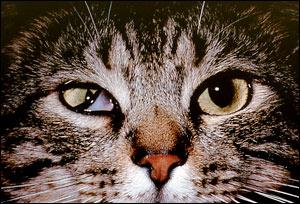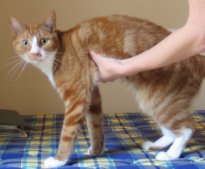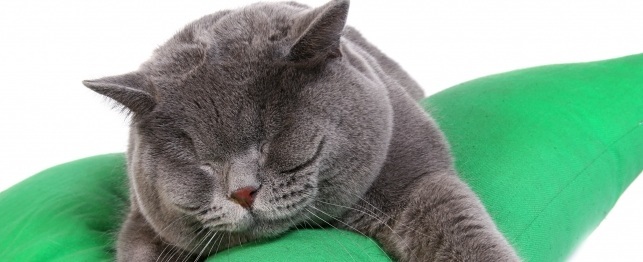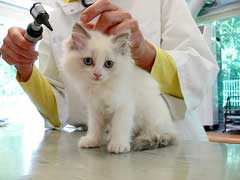
Antifreeze is a common product used in car radiators to lower the freezing point of water in cooler climates. The active ingredient is ethylene glycol (EG), a clear, odourless liquid with a sweet taste which is attractive to cats, dogs and children. In fact, it is known as the 'sweet killer'.
Ethylene glycol is most commonly found in antifreeze, but can be found in other products (see end of article). Antifreeze poisoning is much more common in cooler climates and poisoning rates generally increase in the cooler months. The most common mode of ingestion is when a cat licks antifreeze from a spill on the floor, poisoning may also occur accidentally when a cat walks through a spill, which is then licked off during grooming. Even small amounts can be fatal. As little as a teaspoon or two is enough to kill a cat.
Around 50% of ethylene glycol is excreted by the kidneys, the remainder is metabolised by the liver and converted into toxic metabolites via alcohol dehydrogenase (liver enzymes) into glycoaldehyde, glycolic acid, glyoxylic acid and finally oxalate. Glycolic acid causes metabolic acidosis, oxalate combines with calcium to form calcium oxalate crystals inside the renal (kidney) tubular cells, causing blockage and renal epithelial cell death.
What are the symptoms of antifreeze poisoning in cats?
Signs of poisoning begin very soon after ingestion which occur in three stages.
1) CNS Depression Phase
Antifreeze is rapidly absorbed from the gastrointestinal tract causing irritation and an alcohol like intoxication. Peak blood concentrations occur in approximately 3 hours.
Within 30 minutes to 12 hours of ingestion the cat show the following symptoms:
Your cat will appear intoxicated, stumbling, lack of coordination (ataxia), dizziness.
Extreme thirst.
Excessive urination.
Seizures.
Vomiting due to gastrointestinal irritation.
These symptoms last for approximately 12 hours after ingestion. As CNS depression continues, your cat's thirst will subside, however he will still continue to urinate excessively due to osmotic diuresis, which can lead to dehydration.
2) Cardiopulmonary Toxicity Phase
Approximately 12 - 24 hours after ingestion the following symptoms appear:
Tachypnea (rapid breathing).
Tachycardia (rapid heart rate).
Metabolic acidosis (the blood is too acidic).
Hypertension (high blood pressure).
Lethargy.
Anorexia.
3) Renal Toxicity Phase:
Occurs between 24 - 72 hours after ingestion and includes:
Painful abdomen and/or kidneys.
Cessation of urine output (anuria).
Lethargy.
Vomiting.
Diarrhea.
Mouth ulcers.
Depression.
Seizures.
Coma.
How is antifreeze poisoning in cats diagnosed?
Your veterinarian will take a history from you, including possible exposure to ethylene glycol. He will perform a physical examination of the cat.
A commercial test kit was available for rapid identification of ethylene glycol in whole blood (ethylene glycol test). Known as the REACT Ethylene Glycol Test and produced by PRN Pharmacal. Update 26/11/14-I am not sure if this test is still being produced, as it is no longer listed on their website.
Urinalysis: To detect the presence of calcium oxalate crystals in the urine (crystalluria) and asses kidney damage. Crystals may be present within 3-6 hours of ingestion. Hematuria (blood in urine), proteininuria (protein in urine), and glucosuria (glucose in urine) may also be observed.
Blood Gas: To detect the extent of acidosis.
Ultrasound is performed to view the kidneys and evaluate the extent of damage to the kidneys.
Serum biochemistry to detect low blood calcium, as a result of calcium oxalate formation which depletes calcium levels (hypocalcemia). Hyperkalemia (high blood potassium levels) may also occur due to renal failure.
Some antifreeze products contains the colourant fluorescein, which helps detect radiator leaks. This can cause the cat's urine to glow a bright green colour when viewed under a woods lamp. However, not all ethylene glycol products contain fluorescein, so the absence of this doesn't necessarily rule out poisoning.
Indications:
A cat who presents with vomiting and central nervous symptoms.
Oxalate crystals in the urine.
How is antifreeze poisoning treated?
Successful treatment depends on the amount of antifreeze consumed and how quickly he is seen by a veterinarian. Even so, the prognosis is always guarded. If you suspect your cat has ingested antifreeze, seek veterinary attention immediately.
Treatment is firstly aimed at blocking or decreasing absorption ethylene glycol and preventing the formation of toxic metabolites, removal of the toxin and treatment of the severe metabolic acidosis. This includes:
Induce vomiting, lavage stomach (washing out the stomach with sterile water or a saltwater solution if ingestion has occurred within the past hour) or both.
The effectiveness of activated charcoal to bind to the toxin is somewhat controversial, some veterinarians will administer it to cats suffering from ethylene glycol poisoning.
Administration of ethanol. This should be given as soon as diagnosis is made. Ethanol competes with ethylene glycol for alcohol dehydrogenase, the liver enzyme which converts ethylene glycol into its toxic metabolites.
Sodium bicarbonate is administered to correct metabolic acidosis.
Supportive treatment to include correction of fluid and electrolyte imbalances.
Fluid therapy can also help to increase urine production, speeding up removal of the toxins from the blood.
What other products contain ethylene glycol?
Photographic developing fluid, hydraulic brake fluid, industrial solvents, some cosmetics, some plants, radiator coolant, decorative snow globes, air conditioning coolant.
How to avoid antifreeze poisoning in cats:
Clean up spills immediately.
Always store products containing ethylene glycol in sealed containers out of reach of cats and children.
Keep an eye on leaks in your car and repair as soon as they occur.
Look for products which contain alternatives to ethylene glycol. Many newer products now contain propylene glycol.
Updated 29/8/2014.
 Benadryl For Cats
Benadryl For Cats Benadryl (active ingredient diphenhydramin
Benadryl For Cats
Benadryl For Cats Benadryl (active ingredient diphenhydramin
 Anisocoria in Cats
Anisocoria (unequal pupil sizes) in Cats
Anisocoria in Cats
Anisocoria (unequal pupil sizes) in Cats
 Anaphylaxis in Cats
Anaphylaxis in Cats Also known as allergic shock, anaphylasi
Anaphylaxis in Cats
Anaphylaxis in Cats Also known as allergic shock, anaphylasi
 Facial Swelling in Cats
Facial Swelling in Cats
Facial Swelling in Cats
Facial Swelling in Cats
 Cat Health Insurance Review
We all
Cat Health Insurance Review
We all
Copyright © 2005-2016 Pet Information All Rights Reserved
Contact us: www162date@outlook.com